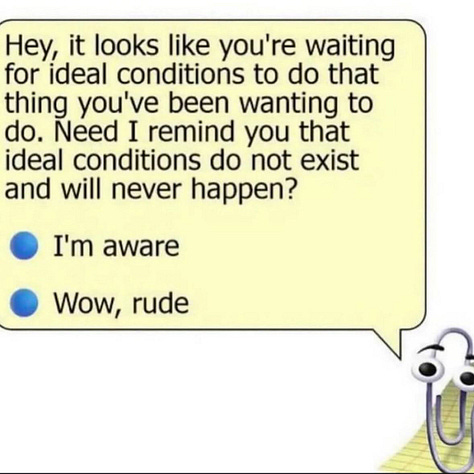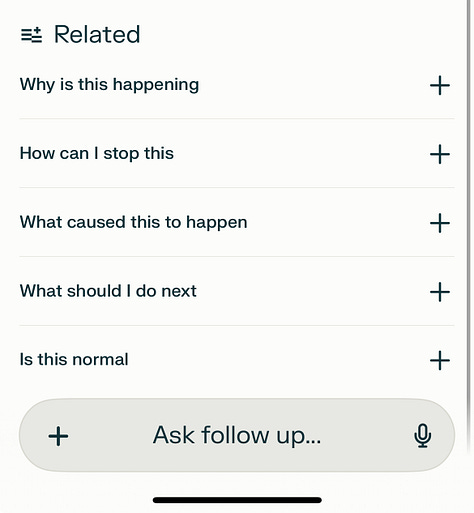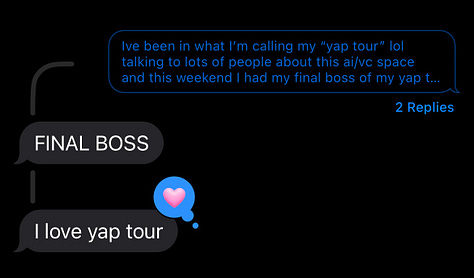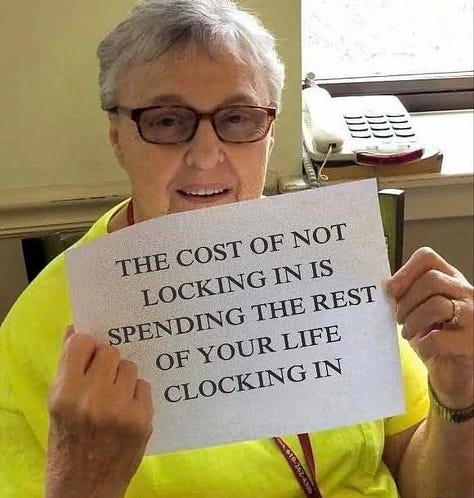Yapping through it
On conversational research, language as access, and figuring things out one coffee at a time
What do you do when you start a new job and don’t know what you’re doing? If you’re me, you talk to everyone.
Over the past two weeks, I’ve had more than 40 conversations with designers, founders, technologists, investors, and weird little internet guys. I’ve been jokingly calling it my Yap Tour—equal parts research sprint, group therapy, and social scavenger hunt. I’m starting something new, and instead of writing a roadmap or spinning up a Notion board, I’ve been yapping my way into clarity.
And you know what? I think it’s working. So today is about language as a tool for learning, about conversation as a form of work, and about how we make meaning when the path isn’t clear. It’s for anyone navigating ambiguity, talking their way into new rooms, or just trying to figure out what the hell they’re doing.
Our stops and table-setting
My first stop on the tour: coffee with
. If you’re venturing into the murky terrain of AI and VC, you’d be lucky to have Melody as your guide. She took my blank-slate self and helped chart a few initial steps: people to meet, events to hit, co-working spaces to swing by. She handed me the map, then vanished—off on a trip, as mysteriously as she arrived.That same evening, I found myself at my very first AI Demo Night. I scanned the crowd. Knew no one. Began questioning every life decision. But then I ran into
, and later . I met people. I watched Los take the stage—dropping apps with lyrical precision—and I was delighted.From there, it all spun out. Old friends. New allies. I learned about developer collectives that feel more like bands than product studios (s/o Danger Testing). I learned how a flower can be a computer, and what an ethical framework might look like when applied to an incubator (thank you, Dean Street boys).
I learned about vibe coding and the less glamorous vibe debugging—how people really are just doing things. I learned the Creative Lab hasn’t changed much, but there’s a new cohort and I can’t wait to see what they do next. I learned that a lot of people are making games and that maybe play is what will show us the way. Then Ghiblification happened and that felt even more true.
I spoke on a panel about freelance vs. full-time (spoiler: the grass is always greener). I re-read the first two chapters of Venture Deals approximately twelve times. I filled my Notes app with deranged entries. Eventually, I knew: it was time to shift gears. To stop spinning and start building. And that’s what I’ve been doing as of late.
Talking as a tool for thinking
In a two-week sprint of coffees, calls, and demo nights, I found myself using conversation not as a way to validate a thesis, but to develop one. I didn’t have a pitch. I wasn’t trying to sell. I was trying to see—who’s excited about what, where the heat is, what feels overbuilt, and what feels underexplored.
This kind of dialogue-led research is particularly useful in spaces like AI and early-stage venture, where the ground shifts weekly and there’s no shared map. It’s also about building trust: showing up, being present, paying attention.
Language as access
When I left Figma, I could talk products, teams, and timelines. I didn’t know how to talk like a VC. Suddenly I was in conversations about SPVs, SAFEs, MCPs, RAG, and evals, furiously Googling between Zooms just to keep up.
One of my favorite conversations was with Trudy Painter, which eventually landed on the nature of language itself. Language isn’t just descriptive—it’s permissioned. It decides which rooms you can enter, what resources you can access, who takes you seriously. It’s a form of capital. And, like capital, it can be learned, practiced, and redistributed.
Over the past decade, I’ve learned to speak fluent agency, fluent in-house, fluent startup. Now, I’m learning to speak AI. And I’m reminded again why I find domain-crossers—like poets who build with multimodal models—so vital. They don’t just speak the language. They expand it.
From role to function
At Figma, my role was clear. There were deliverables. There was a roadmap. There were review cycles. Now? It’s still coming into focus, but functionally, I’m wrangling people, shaping a program, and trying to build the conditions for something excellent to emerge. This kind of ambiguity has forced a mindset shift. Less task executor, more culture shaper. Less following, more initiating. It’s high-agency. See something, don’t just say something—do something. You solve it. Or at least you try.
I’m drawing on everything I’ve done before: running a studio, building community, communications, marketing, and lots of coffees with people from the internet. I’m also building a framework. One that optimizes for building fast, learning publicly, and giving generously.






Future implications
We’re in a moment where work is increasingly fluid and language increasingly programmable. Models speak in natural language. Interfaces dissolve into prompts. Identity—especially online—is shaped less by position, more by performance.
In this world, conversational intelligence is a design skill. Knowing how to ask questions. How to follow up. When to shut up—or make space. How to find your people and bring them along. For anyone building something new: spend time hosting the room. Invite people in. Talk it out. Learn in the open.
AI may be eating the world, but so much of the future will still be shaped by people talking to people and sharing what they’re working on.
Sometimes talking about the work, is the work
In hindsight, the Yap Tour wasn’t a detour. It was the work. Or at least, the beginning of it. Not just for the connections it made, but for how it reframed the job itself.
You don’t always need a plan. Sometimes you need a conversation. Sometimes you just need to talk to enough people until the shape of the thing reveals itself. And if you’re lucky, you’ll find the words—and the people—to help you make sense of it all.
—Carly





“Language isn’t just descriptive—it’s permissioned.” Ooooooh yah!
This is inspiring and reassuring me that all my curious exploring and yapping to everyone around me is part of finding my post-sabbatical path. Thank you for this Carly.